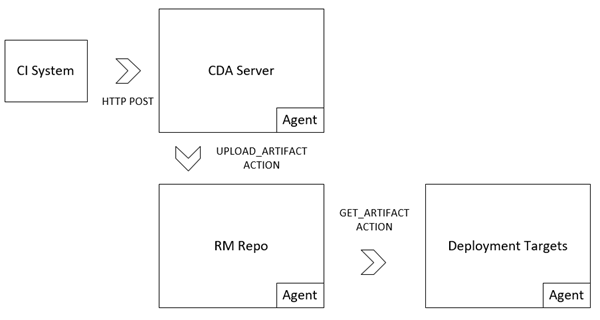Consolidating Artifacts in CDA with the RM Repository
Watch the video:
The RM repo (or CDA artifact source) is a built-in Artifact Source of type "internal repo" that allows you to consolidate Artifacts by providing you with better control, traceability and visibility.
You can access the RM Repo via GUI from the Artifact Sources view.

The Agent-2-Agent file transfer mechanism transfers artifact files from the CDA server to the RM repo via agents. The upload_artifact action uploads the artifacts from the temporary server (CDA) to the RM repo. Once the artifact files are fully uploaded, its main attributes are retrieved and stored in a metadata file.
The Target can then retrieve the artifacts stored in the RM repo via another agent. To do so, the get_artifact action is used.
Important!
- The CDA server and the RM repo can be the same computer and use the same agent. In that case, a local file copy is used instead of the UC4 file transfer.
- The artifact source of type "internal repo" is not available for creating new artifact sources (only one instance can be created, that is, the one set up by the CDA server). This instance cannot be edited in the custom type view either.
- Once a new version of the Internal Repo type is available in CDA, the older versions can no longer be activated. They can only be exported or deleted.
- The ownership of this artifact source is granted to the first non-archived admin user.
- You can activate newer versions of the Internal Artifact Source from the Custom Type view. However, you cannot create new versions of the internal Artifact Source custom type manually.
- The deployment of Artifacts in CDA will be only triggered after the artifact files have been fully uploaded to the Internal Repo Server (Artifact status: uploaded).
- The storage capacity limit used for caching on Targets is 10000 MB.
- For more information on how to configure the cleanup frequency for the RM repo, see Managing the RM Repo
- For more information on how to configure the login parameters to upload the artifact files to the RM-repo, see: <Repository>
- If you want to move the RM Repo to a different location, make sure you manually move its subfolders: client (for example: 100) and blobstore to the same location. The folder structure should be as follows: rm-repo\client\blobstore.
Configuration Settings
You can change the configuration settings of the RM Repo in the RM-Repo Management page. For more information, see: Managing the RM Repo
Configuring a Cleanup Interval for the RM Repo
See: Managing the RM Repo